steering INFINITI QX80 2021 Owner's Manual
[x] Cancel search | Manufacturer: INFINITI, Model Year: 2021, Model line: QX80, Model: INFINITI QX80 2021Pages: 529, PDF Size: 2.05 MB
Page 3 of 529
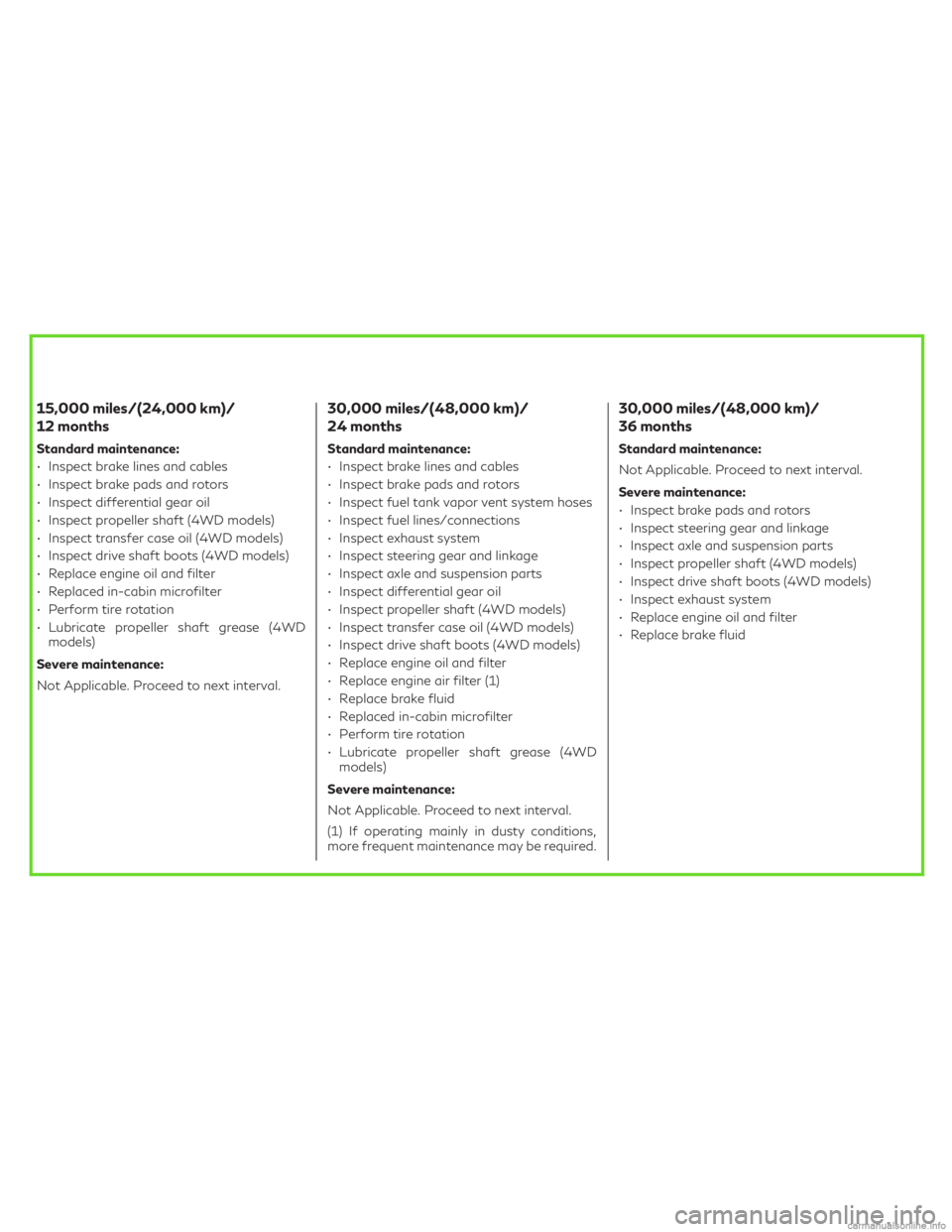
15,000 miles/(24,000 km)/
12 months
Standard maintenance:
• Inspect brake lines and cables
• Inspect brake pads and rotors
• Inspect differential gear oil
• Inspect propeller shaft (4WD models)
• Inspect transfer case oil (4WD models)
• Inspect drive shaft boots (4WD models)
• Replace engine oil and filter
• Replaced in-cabin microfilter
• Perform tire rotation
• Lubricate propeller shaft grease (4WD
models)
Severe maintenance:
Not Applicable. Proceed to next interval.
30,000 miles/(48,000 km)/
24 months
Standard maintenance:
• Inspect brake lines and cables
• Inspect brake pads and rotors
• Inspect fuel tank vapor vent system hoses
• Inspect fuel lines/connections
• Inspect exhaust system
• Inspect steering gear and linkage
• Inspect axle and suspension parts
• Inspect differential gear oil
• Inspect propeller shaft (4WD models)
• Inspect transfer case oil (4WD models)
• Inspect drive shaft boots (4WD models)
• Replace engine oil and filter
• Replace engine air filter (1)
• Replace brake fluid
• Replaced in-cabin microfilter
• Perform tire rotation
• Lubricate propeller shaft grease (4WD
models)
Severe maintenance:
Not Applicable. Proceed to next interval.
(1) If operating mainly in dusty conditions,
more frequent maintenance may be required.
30,000 miles/(48,000 km)/
36 months
Standard maintenance:
Not Applicable. Proceed to next interval.
Severe maintenance:
• Inspect brake pads and rotors
• Inspect steering gear and linkage
• Inspect axle and suspension parts
• Inspect propeller shaft (4WD models)
• Inspect drive shaft boots (4WD models)
• Inspect exhaust system
• Replace engine oil and filter
• Replace brake fluid
Page 4 of 529
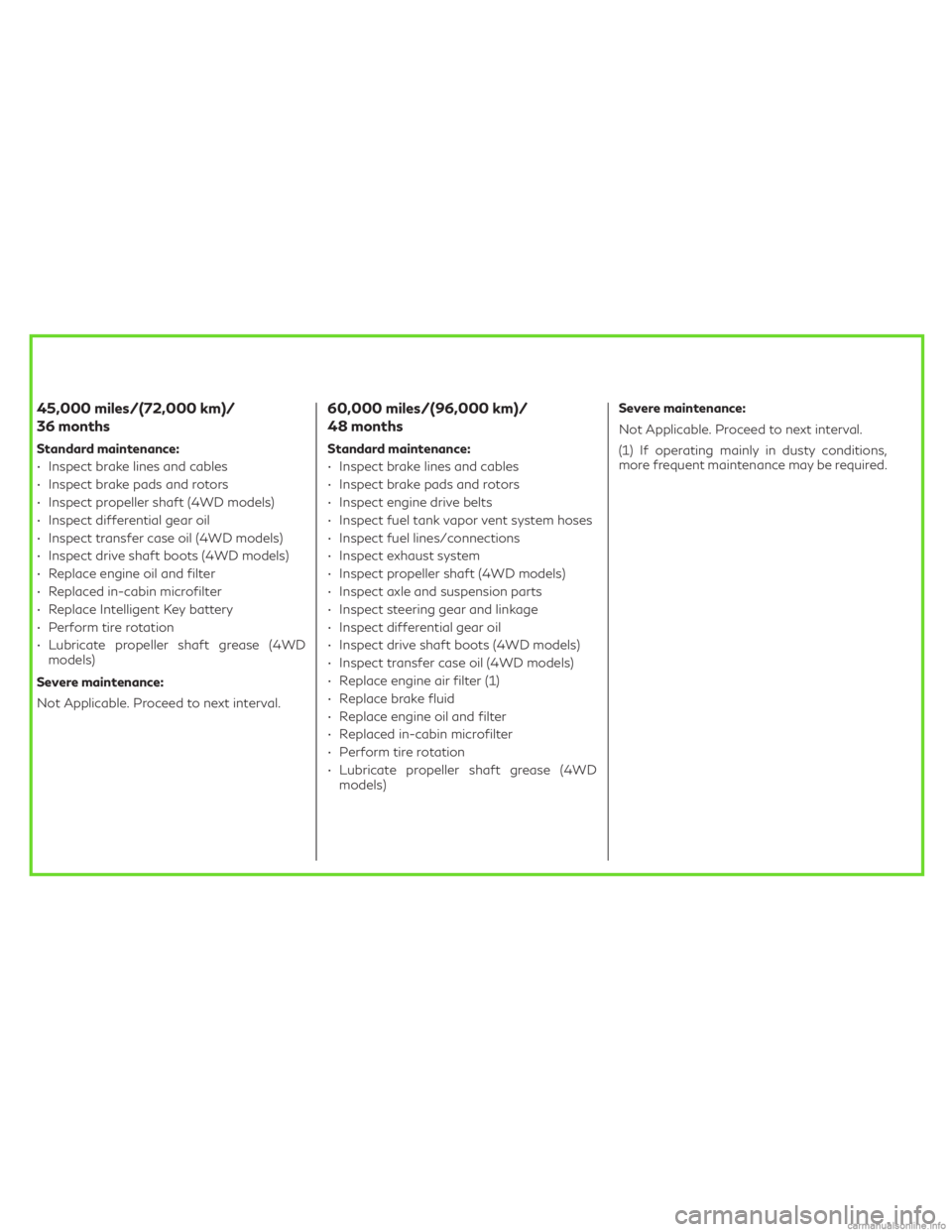
45,000 miles/(72,000 km)/
36 months
Standard maintenance:
• Inspect brake lines and cables
• Inspect brake pads and rotors
• Inspect propeller shaft (4WD models)
• Inspect differential gear oil
• Inspect transfer case oil (4WD models)
• Inspect drive shaft boots (4WD models)
• Replace engine oil and filter
• Replaced in-cabin microfilter
• Replace Intelligent Key battery
• Perform tire rotation
• Lubricate propeller shaft grease (4WD
models)
Severe maintenance:
Not Applicable. Proceed to next interval.
60,000 miles/(96,000 km)/
48 months
Standard maintenance:
• Inspect brake lines and cables
• Inspect brake pads and rotors
• Inspect engine drive belts
• Inspect fuel tank vapor vent system hoses
• Inspect fuel lines/connections
• Inspect exhaust system
• Inspect propeller shaft (4WD models)
• Inspect axle and suspension parts
• Inspect steering gear and linkage
• Inspect differential gear oil
• Inspect drive shaft boots (4WD models)
• Inspect transfer case oil (4WD models)
• Replace engine air filter (1)
• Replace brake fluid
• Replace engine oil and filter
• Replaced in-cabin microfilter
• Perform tire rotation
• Lubricate propeller shaft grease (4WD
models)Severe maintenance:
Not Applicable. Proceed to next interval.
(1) If operating mainly in dusty conditions,
more frequent maintenance may be required.
Page 5 of 529
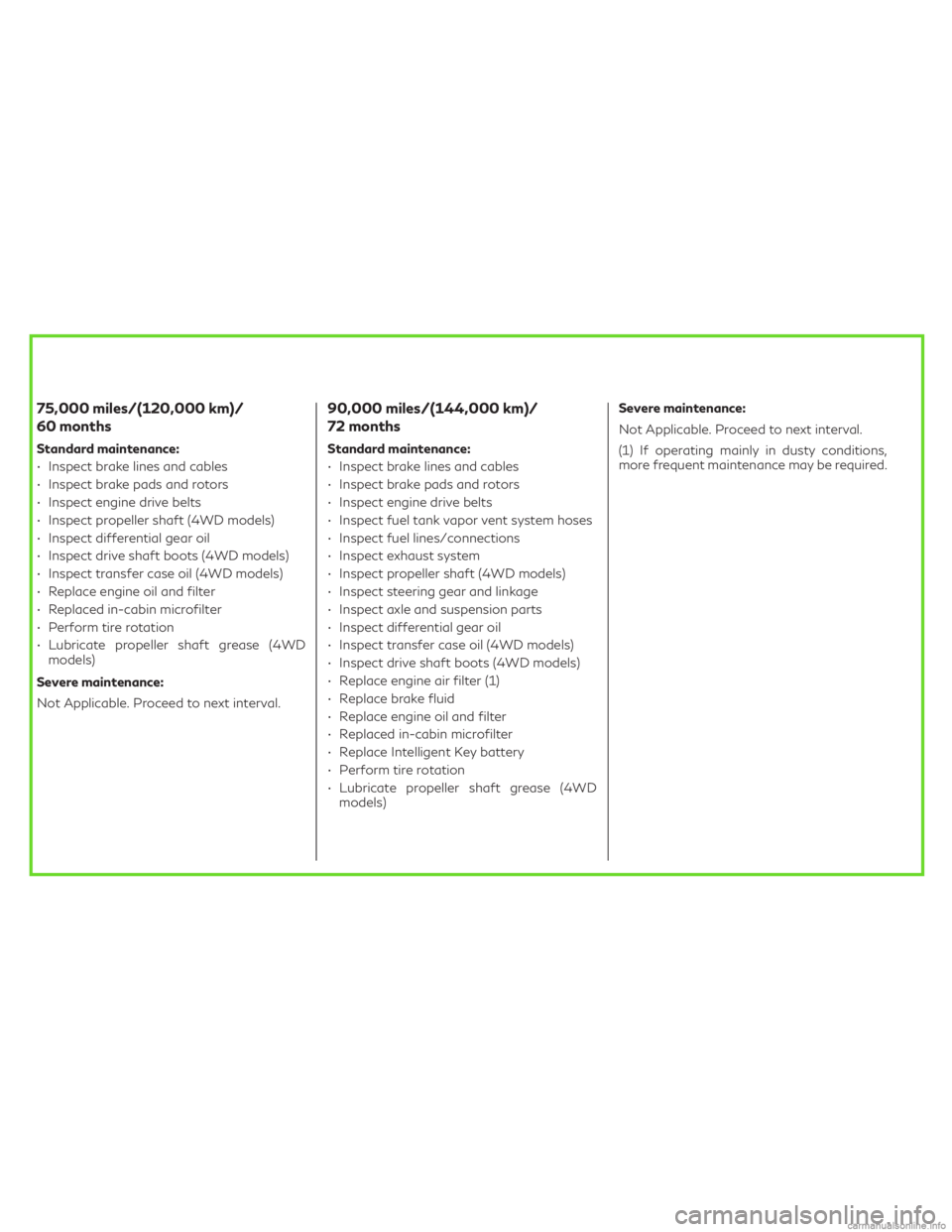
75,000 miles/(120,000 km)/
60 months
Standard maintenance:
• Inspect brake lines and cables
• Inspect brake pads and rotors
• Inspect engine drive belts
• Inspect propeller shaft (4WD models)
• Inspect differential gear oil
• Inspect drive shaft boots (4WD models)
• Inspect transfer case oil (4WD models)
• Replace engine oil and filter
• Replaced in-cabin microfilter
• Perform tire rotation
• Lubricate propeller shaft grease (4WD
models)
Severe maintenance:
Not Applicable. Proceed to next interval.
90,000 miles/(144,000 km)/
72 months
Standard maintenance:
• Inspect brake lines and cables
• Inspect brake pads and rotors
• Inspect engine drive belts
• Inspect fuel tank vapor vent system hoses
• Inspect fuel lines/connections
• Inspect exhaust system
• Inspect propeller shaft (4WD models)
• Inspect steering gear and linkage
• Inspect axle and suspension parts
• Inspect differential gear oil
• Inspect transfer case oil (4WD models)
• Inspect drive shaft boots (4WD models)
• Replace engine air filter (1)
• Replace brake fluid
• Replace engine oil and filter
• Replaced in-cabin microfilter
• Replace Intelligent Key battery
• Perform tire rotation
• Lubricate propeller shaft grease (4WD
models)Severe maintenance:
Not Applicable. Proceed to next interval.
(1) If operating mainly in dusty conditions,
more frequent maintenance may be required.
Page 6 of 529
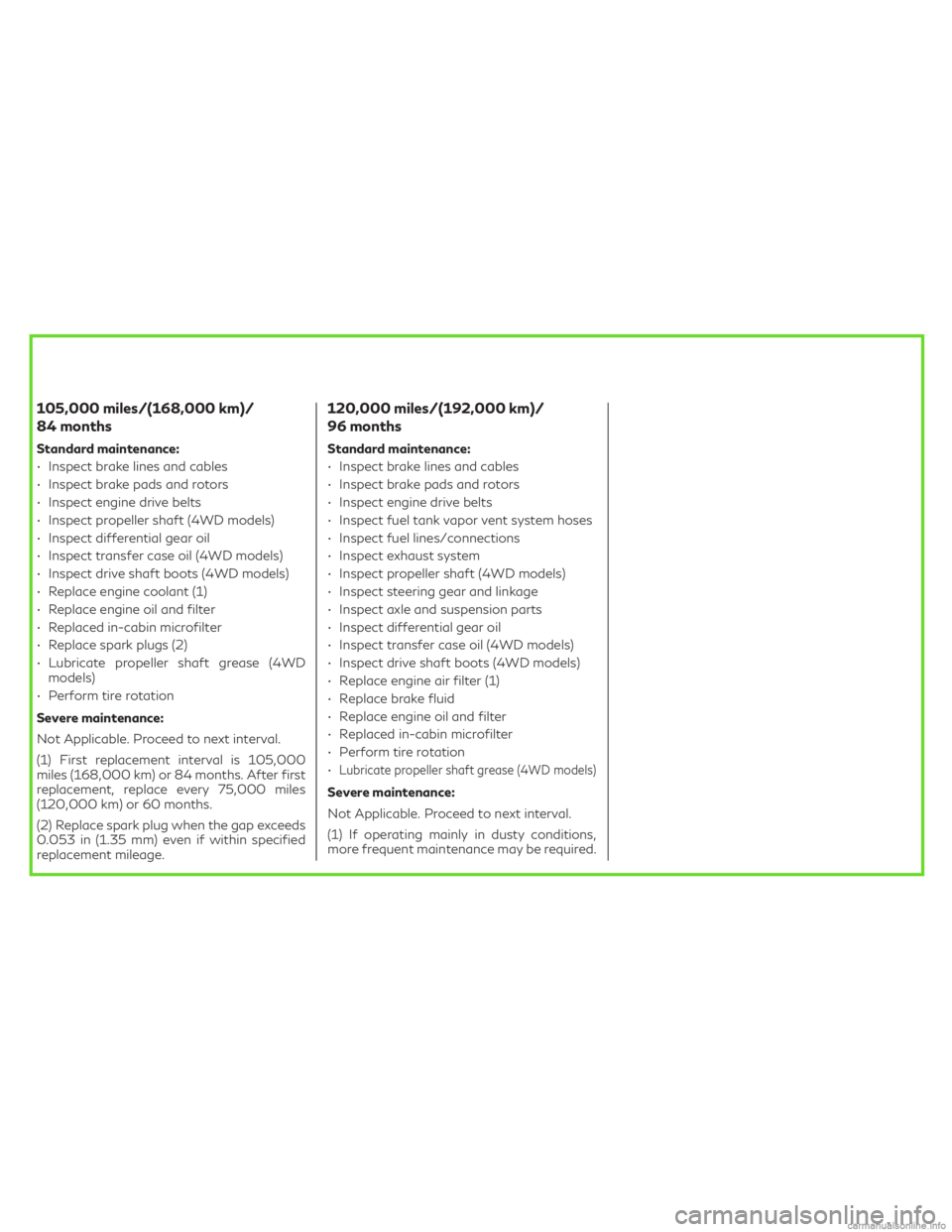
105,000 miles/(168,000 km)/
84 months
Standard maintenance:
• Inspect brake lines and cables
• Inspect brake pads and rotors
• Inspect engine drive belts
• Inspect propeller shaft (4WD models)
• Inspect differential gear oil
• Inspect transfer case oil (4WD models)
• Inspect drive shaft boots (4WD models)
• Replace engine coolant (1)
• Replace engine oil and filter
• Replaced in-cabin microfilter
• Replace spark plugs (2)
• Lubricate propeller shaft grease (4WD
models)
• Perform tire rotation
Severe maintenance:
Not Applicable. Proceed to next interval.
(1) First replacement interval is 105,000
miles (168,000 km) or 84 months. After first
replacement, replace every 75,000 miles
(120,000 km) or 60 months.
(2) Replace spark plug when the gap exceeds
0.053 in (1.35 mm) even if within specified
replacement mileage.
120,000 miles/(192,000 km)/
96 months
Standard maintenance:
• Inspect brake lines and cables
• Inspect brake pads and rotors
• Inspect engine drive belts
• Inspect fuel tank vapor vent system hoses
• Inspect fuel lines/connections
• Inspect exhaust system
• Inspect propeller shaft (4WD models)
• Inspect steering gear and linkage
• Inspect axle and suspension parts
• Inspect differential gear oil
• Inspect transfer case oil (4WD models)
• Inspect drive shaft boots (4WD models)
• Replace engine air filter (1)
• Replace brake fluid
• Replace engine oil and filter
• Replaced in-cabin microfilter
• Perform tire rotation
•
Lubricate propeller shaft grease (4WD models)
Severe maintenance:
Not Applicable. Proceed to next interval.
(1) If operating mainly in dusty conditions,
more frequent maintenance may be required.
Page 21 of 529

0-8Illustrated table of contents
WAA0132X
1. Power liftgate switch (if so equipped)(P.3-22)
2. Heated steering wheel switch (P.2-47)
3. Instrument brightness control switch (P.2-46) 4. TRIP/RESET switch for twin trip od-
ometer (P.2-7)
5. Headlight, fog light and turn signal switch
— Headlight (P.2-40)
— Turn signal (P.2-46) — Fog light (P.2-47)
6. Steering-wheel-mounted controls (left side)
— Audio control steering switch (See
INFINITI InTouch
TMOwner’s Manual.)
— Hands-Free Phone System switch
(See INFINITI InTouch
TMOwner’s
Manual.)
— Trip computer switch (P.2-31)
7. Wiper and washer switch (P.2-36)
8. Steering-wheel-mounted controls (right side)
— Cruise control system (if so
equipped) (P.5-62)
— Intelligent Cruise Control (ICC) sys-
tem (if so equipped) (P.5-64)
9. Dynamic driver assistance switch (if so equipped)
— Lane Departure Prevention (LDP)
system (if so equipped) (P.5-22)
— Distance Control Assist (DCA) sys-
tem (if so equipped) (P.5-84)
— Blind Spot Intervention
®(BSI) sys-
tem (if so equipped) (P.5-41)
10. Shift lever (P.5-17)
11. INFINITI controller (See INFINITI In- Touch
TMOwner’s Manual.)
COCKPIT
Page 22 of 529

12. Four-Wheel Drive (4WD) shift switch(if so equipped) (P.5-113)/SNOW
mode switch (P.2-52)/TOW mode
switch (P.2-53)/Vehicle Dynamic Con-
trol (VDC) OFF switch (P.5-125)
13. Headlight aiming control (if so equipped) (P.2-44)
14. Power liftgate main switch (P.3-22)
15. Warning systems switch (P.2-52) — Lane Departure Warning (LDW)
(P.5-22)
— Blind Spot Warning (BSW) (P.5-31)
16. Remote tip-up 2nd row seat switch (if so equipped) (P.1-6)
17. Rear door alert switch (P.2-54)
18. Electric tilting/telescopic steering wheel switch (P.3-29)
Illustrated table of contents0-9
Page 23 of 529

0-10Illustrated table of contents
WAA0133X
1. Side ventilator (P.4-27)
2. Meters and gauges (P.2-6)
3. Hazard warning flasher switch (P.6-2)
4. Center ventilator (P.4-27)
5. Upper touch screen display (upper dis-play) (See INFINITI InTouch
TMOwner’s Manual.)
— Around View
®Monitor (P.4-3)
— Navigation system (See INFINITI
InTouch
TMOwner’s Manual.) 6. Lower touch screen display (lower dis-
play) (See INFINITI InTouch
TMOwner’s
Manual.)
7. Heater and air conditioner control (P.4-28)
— Heated seats switch (P.2-48)
— Climate controlled seats switch (if so
equipped) (P.2-50)
— Defroster switch (P.2-39)
8. Front passenger air bag status light (P.1-60)
9. Audio system (See INFINITI InTouch
TM
Owner’s Manual.)
10. Front passenger supplemental air bag (P.1-52)
11. Fuse box (P.8-20)
12. Parking brake (P.5-22)
13. Hood release handle (P.3-21)
14. Steering wheel — Horn (P.2-48)
— Driver supplemental air bag (P.1-52)
— Power steering system (P.5-123)
15. Push-button ignition switch (P.5-12)
16. Front console — Power outlet (P.2-56)
— USB connection port (See Infiniti
InTouch Owner’s Manual.)
INSTRUMENT PANEL
Page 26 of 529

WAA0134X
VK56VD ENGINE
1. Window washer fluid reservoir(P.8-10)
2. Fuse/fusible link holder (P.8-18)
3. Engine oil dipstick (P.8-6)
4. Power steering fluid reservoir (P.8-8) 5. Engine oil filler cap (P.8-6)
6. Brake fluid reservoir (P.8-9)
7. Fuse/fusible link holder (P.8-18)
8. Battery (P.8-11)
9. Radiator filler cap (P.8-4)
10. Engine coolant reservoir (P.8-4)11. Drive belts (P.8-13)
12. Air cleaner (P.8-14)
Illustrated table of contents0-13
ENGINE COMPARTMENT
Page 48 of 529
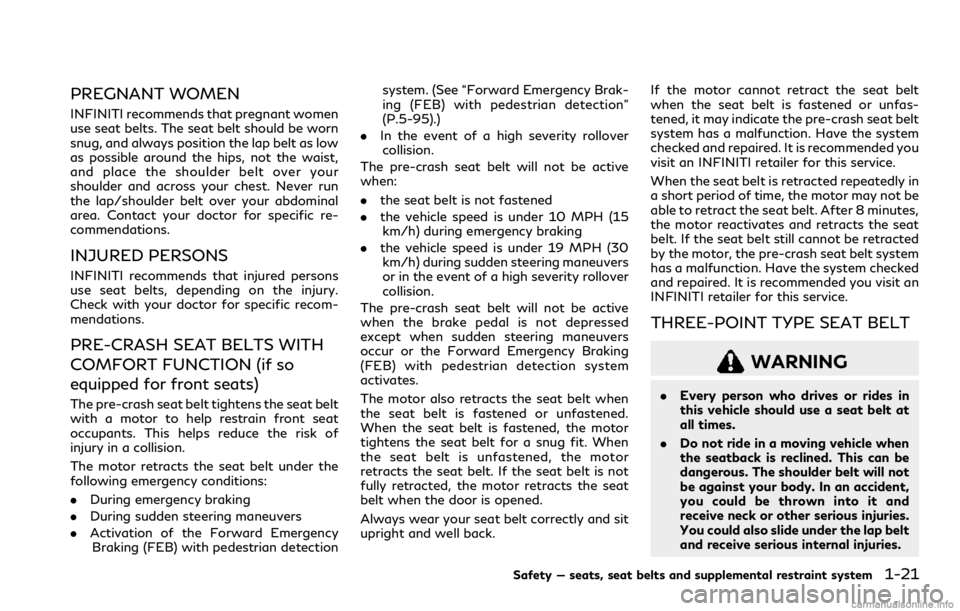
PREGNANT WOMEN
INFINITI recommends that pregnant women
use seat belts. The seat belt should be worn
snug, and always position the lap belt as low
as possible around the hips, not the waist,
and place the shoulder belt over your
shoulder and across your chest. Never run
the lap/shoulder belt over your abdominal
area. Contact your doctor for specific re-
commendations.
INJURED PERSONS
INFINITI recommends that injured persons
use seat belts, depending on the injury.
Check with your doctor for specific recom-
mendations.
PRE-CRASH SEAT BELTS WITH
COMFORT FUNCTION (if so
equipped for front seats)
The pre-crash seat belt tightens the seat belt
with a motor to help restrain front seat
occupants. This helps reduce the risk of
injury in a collision.
The motor retracts the seat belt under the
following emergency conditions:
.During emergency braking
. During sudden steering maneuvers
. Activation of the Forward Emergency
Braking (FEB) with pedestrian detection system. (See “Forward Emergency Brak-
ing (FEB) with pedestrian detection”
(P.5-95).)
. In the event of a high severity rollover
collision.
The pre-crash seat belt will not be active
when:
. the seat belt is not fastened
. the vehicle speed is under 10 MPH (15
km/h) during emergency braking
. the vehicle speed is under 19 MPH (30
km/h) during sudden steering maneuvers
or in the event of a high severity rollover
collision.
The pre-crash seat belt will not be active
when the brake pedal is not depressed
except when sudden steering maneuvers
occur or the Forward Emergency Braking
(FEB) with pedestrian detection system
activates.
The motor also retracts the seat belt when
the seat belt is fastened or unfastened.
When the seat belt is fastened, the motor
tightens the seat belt for a snug fit. When
the seat belt is unfastened, the motor
retracts the seat belt. If the seat belt is not
fully retracted, the motor retracts the seat
belt when the door is opened.
Always wear your seat belt correctly and sit
upright and well back. If the motor cannot retract the seat belt
when the seat belt is fastened or unfas-
tened, it may indicate the pre-crash seat belt
system has a malfunction. Have the system
checked and repaired. It is recommended you
visit an INFINITI retailer for this service.
When the seat belt is retracted repeatedly in
a short period of time, the motor may not be
able to retract the seat belt. After 8 minutes,
the motor reactivates and retracts the seat
belt. If the seat belt still cannot be retracted
by the motor, the pre-crash seat belt system
has a malfunction. Have the system checked
and repaired. It is recommended you visit an
INFINITI retailer for this service.
THREE-POINT TYPE SEAT BELT
WARNING
.
Every person who drives or rides in
this vehicle should use a seat belt at
all times.
. Do not ride in a moving vehicle when
the seatback is reclined. This can be
dangerous. The shoulder belt will not
be against your body. In an accident,
you could be thrown into it and
receive neck or other serious injuries.
You could also slide under the lap belt
and receive serious internal injuries.
Safety — seats, seat belts and supplemental restraint system1-21
Page 79 of 529

1-52Safety — seats, seat belts and supplemental restraint system
PRECAUTIONS ON SUPPLE-
MENTAL RESTRAINT SYSTEM
This Supplemental Restraint System (SRS)
section contains important information con-
cerning the following systems.
.Driver and passenger supplemental
front-impact air bag (INFINITI Advanced
Air Bag System)
. Front seat-mounted side-impact supple-
mental air bag
. Roof-mounted curtain side-impact and
rollover supplemental air bag
. Seat belt with pretensioner
Supplemental front-impact air bag system:
The INFINITI Advanced Air Bag System can
help cushion the impact force to the head
and chest of the driver and front passenger
in certain frontal collisions.
Front seat-mounted side-impact supple-
mental air bag system: This system can help
cushion the impact force to the chest and
pelvis area of the driver and front passenger
in certain side impact collisions. The supple-
mental side air bag is designed to inflate on
the side where the vehicle is impacted.
Roof-mounted curtain side-impact and roll-
over supplemental air bag system: This
system can help cushion the impact force
to the head of occupants in front and rear
(2nd and 3rd) outboard seating positions in certain side impact or rollover collisions. In a
side impact, the curtain air bags are designed
to inflate on the side where the vehicle is
impacted. In a rollover, the curtain air bags
on both sides are designed to inflate. Under
both side-impact and rollover situations, the
curtain air bags will remain inflated for a
short period of time.
These supplemental restraint systems are
designed to
supplement the crash protection
provided by the driver and passenger seat
belts and are not a substitute for them. Seat
belts should always be correctly worn and
the occupant seated a suitable distance
away from the steering wheel, instrument
panel and door finishers. (See “Seat belts”
(P.1-18) for instructions and precautions on
seat belt usage.)
The supplemental air bags operate only
when the ignition switch is in the ON
position.
After pushing the ignition switch to the ON
position, the supplemental air bag warning
light illuminates. The supplemental air bag
warning light will turn off after about 7
seconds if the systems are operational.
SUPPLEMENTAL RESTRAINT SYSTEM